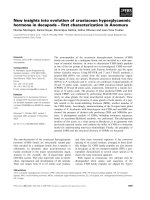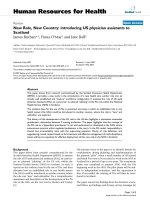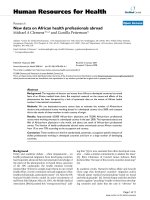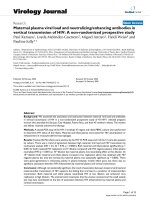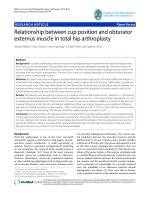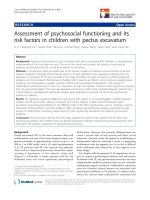Báo cáo sinh học: "New investigations around CYP11A1 and its possible involvement in an androstenone QTL characterised in Large White pigs" pdf
Bạn đang xem bản rút gọn của tài liệu. Xem và tải ngay bản đầy đủ của tài liệu tại đây (252.72 KB, 6 trang )
RESEARCH Open Access
New investigations around CYP11A1 and its
possible involvement in an androstenone QTL
characterised in Large White pigs
Annie Robic
1*
, Guillaume Le Mignon
2
, Katia Fève
1
, Catherine Larzul
2
and Juliette Riquet
1
Abstract
Background: Previously, in boars with extreme androstenone levels, differential expression of the CYP11A1 gene in
the testes has been characterised. CYP11A1 is located in a region where a QTL influencing boar fat androstenone
levels has been detected in a Large White pig population. Clarifying the role of CYP11A1 in boar taint is important
because it catalyses the initial step of androstenone synthesis and also of steroid synthesis.
Results: A genome-wide association study located CYP11A1 at approximately 1300 kb upstream from SNP
H3GA0021967, defining the centre of the region containing the QTL for androstenone variation. In this study, we
partially sequenced the CYP11A1 gene and identified several new single nucleotide polymorphisms (SNP) within it.
Characterisation of one animal, heterozygous for CYP11A1 testicular expression but homozygous for a haplotype of
a large region containing CYP11A1, reveale d that variation of CYP11A1 expression is probably regulated by a
mutation located downstream from the SNP H3GA0021967. We analysed CYP11A1 expression in LW families
according to haplotypes of the QTL region’s centre. Effects of haplotypes on CYP11A1 expression and on
androstenone accumulation were not concordant.
Conclusion: This study shows that testicular expression of CYP11A1 is not solely respons ible for the QTL
influencing boar fat androstenone levels. As a conclusion, we propose to refute the hypothesis that a single
mutation located near the centre of the QTL region could control androstenone accumulation in fat by regulating
the CYP11A1 expression.
Background
Boar taint refers to an unpleasant odour and flavour of
meat which occurs in a high proportion of uncastrated
male pigs and i s primarily due to the accumulation of
androstenone and skatole in fat tissue [1,2]. Androst e-
none is synthesised in the testis, together with the steroid
hormones, and rog ens and estr ogens, from pregnenolone
[3-5], in relation to sexual development and i s stored in
fat tissue because of its lipophilic properties.
Currently, only a few studies have tried to identify QTL
for androstenone accumulation [6-9]. It is important to
understand the genetic mechanisms controlling this trait
in order to be able to select pigs for low androstenone
levels and thus limit the occurrence of boar taint.
Le Mignon et al. [10] identified QTL for androstenone
variation in a 480 Large White (LW) pig population using
the Illumina PorcineSNP60 BeadChip. The present study
focused on one of these QTL, explaining 18.7% of the
genetic variance, which was detected on the q-arm of
chromosome Sus scrofa 7 (SSC7) using GWAS (Genome
Wide Association Studies) near the position 66 Mb on
the “ Sscrofa9“ version (April 2009) of the pig genome
sequence. Examination of the gene content in this QTL
region, suggested CYP11A1 as an obvious candidate gene.
Moe et al. [11] and Grindfleck et al. [12] had already
detected differential expression of CYP11A1 in the testes
of boars with either extremely high and or low levels of
androstenone in fat. Moreover, a previous study reported
one polymorphism in exon 1 of CYP11A1 significan tly
associated with androstenone levels in Yorkshire b oars
[13]. This gene encodes the CYP11A1 enzyme, which is
localized in the mitochondrial inner membrane, and
* Correspondence:
1
INRA, UMR444, Laboratoire de Génétique Cellulaire, 31326 Castanet-Tolosan,
France
Full list of author information is available at the end of the article
Robic et al. Genetics Selection Evolution 2011, 43:15
/>Genetics
Selection
Evolution
© 2011 Robic et al; licensee BioMed Central Ltd. This is an Open Access article distributed under the terms of t he Creative Commons
Attribu tion Lice nse (http://creativecommons.o rg/licenses/by/2.0), which pe rmits unrestricted use, distribution, and reproduction in
any medium, provided t he original work is properly cited.
catalyses the conversion of cholesterol to pregnenolone in
the first and rate-limiting step of the synthesis of steroid
hormones [14]. Therefore, it is very important to clarif y
the role of CYP11A1 in boar taint. If testicular expression
of CYP11A1 is found to infl uence the QTL for androste-
none variation, i t would be difficult to select against this
QTL without encountering reproduction problems.
Methods
Animals and samples
On the INRA experimental farm, 98 LW sows were inse-
minated with 56 LW boars, chosen as unrelated as possi-
ble. Each boar inseminated one o r two sows. A total of
580 mal e piglets were raised in pens ti ll they reached
110kgoflivebodyweightandthenslaughteredina
commercial slaughterhouse. A total of 480 animals were
measured for backfat androstenone levels.
Six litters were produced b y inseminating LW so ws
with semen from two commercial LW boars. Twenty-
two animals were produced and then slaughtered at 24-
25 weeks of age. Testicular samples were collected
immediately after slaughter, frozen in liquid nitrogen
and stored at -80°C. To obtain testicul ar samples, testes
were decapsulated to remove connective tissues, fasciae
and the main blood vessels. Samples (2 to 5 cm
3
)were
collected from the inner part of the testicular tissue,
containing Leydig cells.
Real time PCR
Samples were disrupted, homogenised a nd ground to a
fine powder by rapid agitation for 1 min in a liquid-
nitrogen-cooled grinder with stainless steel beads
before RNA extraction. Total RNA was isolated from
testis using Total Quick RNA (Talent ) kits according
to the manufacturers’ instructions, and treated with
DNase to remove contaminating DNA. RNA concen-
tration was determined using the NanoDrop ND-1000
spectrophotometer (NanoDrop Technologies, DE,
USA). First strand cDNA synthesis was conducted
using SuperScript™-II Rnase H- Reverse Transcriptase
(Invitrogen, Carlsbad, CA). According to the manufac-
turer’ s instructions, 0.5 μg of total RNA from each
sample was used as a template with d N9 random pri-
mers (Ozyme, New England Biolabs), in a total volume
of 100 μL.
The level of CYP11A1expression was determined by
real-time P CR on cDNA from testes. Experiments were
performed on the ABI 7900HT (Sequence Detection
System 7900HT) in a 384-w ell plate. All measurements
were performed in duplicate on the same plate and no
reference sample was used. Primers were designed in
exon 3 (TGTTTCGCTTCGCCTTTGA) and exon 4
(CCCAGGCGCTCTCCAAAT) of CYP11A1 cDNA.
Transcript’s concentrations were corrected with respect
to the housekeeping gene , TOB2B (GGGATGTCTG AA-
GAAGTACGAAAC//CATTCCTACAAGCCATTCCT-
TACG). Dat a was analysed with ABI software to obtain
Ct values (threshold cycle). Four points of di lutions of a
mix of cDNA were used for each gene and for each tis-
sue, to determine PCR efficiency (E). As efficiency levels
were similar for all measured genes (including the refer-
ence gene), results are expressed as E
(Ct_ref - Ct_gene)
×
1000 in arbitrary units.
Before quantifying CYP11A1 transcripts, possible alter-
native transcripts were compiled from databases and we
checked that the alternative transcript (AK235955 or
DB787788) with a 3’ shortcut exon 3 was absent in the
testicular cDNA.
Sequences
Sequencing of BAC CH242-402H 17 containi ng
CYP11A1 gen e related sequences is underwa y and sub-
clone sequences are being captured by a blast procedure
( />BlastGen.cgi?taxid=9823) from the “ traces-other”
database.
To find polymorphisms, PCR products were produ ced
with genomic DNA from several animals. To sequence the
PCR products, an aliquot (1 to 12 μL) was purified by a
single treatment (45 min at 37°C followed by 30 min at
80°C) using 0.5 U o f Shrimp alkaline phosphatase (Pro-
mega) and 0.8 U of exonuclease I (New England Biolabs).
Sequencing was done with a 3730 ABI capillary DNA
sequencer using a Big Dye terminator V3.1 cycle sequen-
cing kit.
Statistical analysis
Differences between two groups of animals were
assessed with a heteroscedastic Student’st-testaspro-
posed by MS-Excel (Microsoft Corporation).
Results and discussion
QTL region
The 18 informative SNP present in the region containing
the QTL for androstenone variation were classified into
four groups based on their positions in Mb (Figure 1).
The position of this QTL was arbitrarily defined in a win-
dow of 3 Mb around the most highly associated marker,
H3GA0021967 (named M11 and located at 65.91 Mb on
the “Sscrofa9“ provisional genome sequence), identified
by GWAS analysis [10]. Since sequencing of the porcine
genome is not yet completed [15], our results are
anchored on the human map. The genomic content of
this region (64.4 - 67.4 Mb) was deduce d from the global
alignment propos ed by th e Narcisse so ftware [16]. The
first part of the QTL region between 64.4 0 and 66. 45 Mb
corresponded to the CYP11A1-GRAM D2 reg ion from
HSA15 (Figure 1) and the second part between 66.45 and
Robic et al. Genetics Selection Evolution 2011, 43:15
/>Page 2 of 6
67.40 Mb was homologous to HSA14 (SEC23A-SSTR1).
The information was completed and compared to the
provisional annotation of the “Sscrofa9”version available
on the Ensembl web site ( We
found that the assembly between 66.0 and 66.4 Mb did
not coincide completely although the SNP order was cor-
rect (Figure 1). Moreover, four small gaps were detected
(Figure 1) and in particular, close to the porcine position
64.6 Mb. Using the Blast procedure available on the
Ensembl web site, we showed that the 55 kb fragment
on “ Sscrofa9” separating the extremities of UBL7 and
CCDC33 genes did not contain sequences related to the
SEMA7A and CYP11A1 genes. Curiously, on the human
sequence, this region extended over a total of about
73 kb and contained these two genes which did not over-
lap but extended over 25 and 30 kb, respectively.
Porcine CYP11A1 gene
CYP11A1 appeared to be a promising candidate gene for
the QTL for androstenone variation since its product,
the CYP11A1 enzyme, catalyses the initial step of
androstenone synthesis. Moreover, Moe et al. [11] and
Grindfleck et al. [12 ] had already detec ted differential
expression of CYP11A1 in the testes of boars with var-
ious extreme androstenone levels in fat. The cDNA of
CYP11A1 is known in pig (NM_214427) and the
sequencing of BAC CH242-402H17 is underway. We
performed several assemblies of sub-clone sequences
64 65
74
75
73
72Mb
on GRCh37
66 67 68
69 Mb
on Sscrofa9
SSC7
UBL7
CCDC33
LOXL1
STOML1
PML
TBC1D21
NPTN
CD276
ISLR
ISLR2
STRA6
HCN4
PKM2
SEC23A
SSTR1
MIPOL1
FOXA1
TTC6
PARP6
BRUNOL6
HEXA
TMEM202
BBS4
ADPGK
NEO1
ARIH1
GRAMD2
Informative
SNPs
M1-M6
SW1418
M7-M10
M11-M14
M15-M18
Androstenone QTL region
CYP11A1
ex1
ex9
*
R
microsatellite
R
(Grindfleck et al. 2010)
R
R
Y
(Greger 2000)
WK
Polymorphisms
HQ687747
HSA15
LOXL1
STOML1
GOLGA6
GOLGA6B
HIGD2B
ISLR
CD276
TBC1D21
NPTN
ISLR2
HCN4
GRAMD2
PKM2
PARP6
BRUNOL6
ARIH1
TMEM202
SENP8
HEXA
MYO9A
ADPGK
BBS4
NEO1
UBL7
CCDC33
PML
STRA6
CYP11A1
SEMA7A
39
38
37Mb
on GRCh37
HSA14
SEC23A
MIPOL1
SSTR1
FOXA1
CLEC14A
TTC6
Figure 1 Schematic representation of the SSC7 and human homologous regions. Center part: schematic representation of genes in the 64-69 Mb
SSC7 region (in accordance with the sscrofa9 draft sequence); top left hand side: HSA15 segment homologous to the left half of this SSC7 region; lower
right hand side: HSA14 s egment ho mologous to the r ight half of this SSC7region; each gene sequenc e is represented by an arrow i.e. full arrow if
homologous porcine gene exists and ho llow arrow if not ; lower l eft h and side: representat ion of p art of the p orcine sequence g ap i ncluding CYP11A1
with its structure schematized showing the location of t he polymorphisms characterised in thi s study i .e. one SNP (R in IUPAC cod ification) and one
microsatellite identified in the dista nt 5 ’ flanking sequence; SNP (Y) patented by Greger [18] was found in the proximal promoter and SNP (R) previously
characterised by Grindfleck et al. [12] was found in the first exon; two new SNP (R and R) in the first intron and two consecutive SNP (WK) in the second
intron were also detected; composition and position in Mb (Sscrofa9) of SNP marker groups: (1 ) ove r the 64.38-64.6 5 Mb region with M1 =
ALGA0042289; M2 = I NRA0026201; M3 = ASGA0034277; M4 = DRGA007689; M5 = A LGA0042294; M6 = H3GA0021937; (2) over the 65.13-65.33 Mb
region with M7 = A SGA0034288; M8 = INRA0026223; M9 = A LGA0042315; M10 = ASGA0034291; (3) over the 65.91-66.11 Mb region with M11 =
H3GA0021967; M12 = ASGA0034309; M13 = ASGA0034310; M14 = MARC0076146 an d (4) ove r the 68.27 -68.56 Mb r egion w ith M15 = INRA0026286;
M16 = MARC0099388; M17 = inra0026290; M18 = ALGA0042359
Robic et al. Genetics Selection Evolution 2011, 43:15
/>Page 3 of 6
starting with exon sequences. To capture the 5’ flanking
sequence, we used human sequences and in particular a
regulatory region (HSA15 :74665162-74667983). We
were able to propose an initial assembly (HQ687747)
with four genomic fragments schematized on Figure 1.
CYP11A1 gene is composed of nine exons in most
mammals. Pig intron 1 (3205 bp) is significantly shorter
than the human counterpart (19261 bp) but longer than
the mouse one (975 bp). To characterise polymorph-
isms, the corresponding human 19 kb long intron 1 was
sequenced in several animals chosen from the 480 LW
animals. One SNP (R according to IUPAC codification)
and one microsatellite were identified in the distant 5’
flanking sequence. SNP (Y) patented by Greger [17] was
found in the proximal promoter and SNP (R), previously
characterised by Grindfleck et al. [12], was found in the
first exon. In the first intron, two new SNP (R and R)
and in the second intron, two consec utive SNPs (WK)
were detected. Thus, seven SNP and two microsatel lites
(with SW1418) were available to explore the CYP11A1
region.
Expression of CYP11A1
It would have been interesting to analyse variations of the
testicular CYP11A1 expression in animals from this LW
population but no samples were available. Fortunately,
expression of CYP11A1 in the testis of animals from
other LW families could be estimated by real-time PCR.
The results are shown in Table 1. In family A, the level of
CYP11A1 expression ranged between 200 and 600 A.U.
in the seven an imals analysed, while in family B, two ani-
mals with a very high level o f CYP11A1 expression
(1425) and two animals with a low level (250) were
found. Moreover four mi crosatellites w ere genotyped
around CYP11A1 [see additional file 1, Table S1], which
allowed to deduce that the boar is homozygous -/-, the
sow (61043) of family A is homozygous -/- and the sow
(65472) of family B is heterozygous +/- for CYP11A1ex-
pression level. Nevertheless, it is very likely that this latter
sow (65472) is ho mozygous for the entire haplotype over
this region [see additional file 1, Table S1].
Haplotype analysis in the CYP11A1 region
Sow 65472 was genotyped for the 21 SNP (M1-M14 and 7
SNP related to CYP11A1) and for two microsatellites
(located 5’ of CYP11A1 and SW1418). With the exception
of M12, M13 and M14, all the markers were homozygous
(data not shown). This female appeared to be homozygous
for a large region (M1-M11 ) including SNP H3GA0021967.
We examined the haplotypes of 480 LW animals for 14
SNP (M1 to M14) from the CYP11A1 region and found
that 14 animals shared t he same two SSC7 chromosomal
regions present in sow 65472. Nevertheless, genotyping for
three markers inside the CYP11A1 gene did not detect any
animal carrying the 65472 sow’shaplotype.Thus,we
believe that the number of genotyped SNP is sufficient to
assume that sow 65472 is homozygous for a large region
(M1-M11) including SNP H3GA0021967.
Since sow 65472 is considered as heterozygous for
CYP11A1 expression level and homozygous for a hap-
lotype in the M1-M11 large region, we hypothesized
that the mutation controlling CYP11A1 expression is
located downstream M11. This region was superim-
posed on the androstenone QTL region, which enabled
us to suggest that a unique mutation located near the
centre of the QTL region (M11-M14) could control
androstenone accumulation in fat by regulating the
CYP11A1 expres sio n.
Table 1 Testis CYP11A1 expression in two LW families
qPCR on RT products of RNA from testis [CYP11A1]
Haplotypes SSC7/SSC7 Descendant Haplotypes SSC7/SSC7 qPCR Arbitrary units
Boar 1 Pat1/Pat2 Family A Dam 61043 75082 Mat1/Pat2 463
Boar 1 Pat1/Pat2 Family A Mat1/Mat2 75083 Pat2/Mat1 224
Boar 1 Pat1/Pat2 Family A 75084 Pat1/Mat2 586
Boar 1 Pat1/Pat2 Family A 75085 Pat1/Mat2 199
Boar 1 Pat1/Pat2 Family A 75086 Pat1/Mat1 260
Boar 1 Pat1/Pat2 Family A 75087 Pat2/Mat2-Mat1 604
Boar 1 Pat1/Pat2 Family A 75088 Pat2/Mat2 408
Boar 1 Pat1/Pat2 Family B Dam 65472 75010 Pat1/Mat3 1440
Boar 1 Pat1/Pat2 Family B Mat1/Mat3 75011 Pat2/Mat3 1410
Boar 1 Pat1/Pat2 Family B 75012 Pat2/Mat1 273
Boar 1 Pat1/Pat2 Family B 75014 Pat2/Mat1 227
In this table we report the results of the quantification of CYP11A1 expression in the testis [Cyp11A1]; contrary to animals in family A, in family B, the level of
CYP11A1expression in descendants could be distinguished as a function of their maternal SSC7 chromosome; for more details on the characterisation of SSC7,
[see additional file 1, Table S1] and for the quantification of CYP11A1 expression on testes for a ll the animals of the six families see Table 3.
Robic et al. Genetics Selection Evolution 2011, 43:15
/>Page 4 of 6
Haplotype analysis in the centre of the QTL region
We examined the haplotypes between M11-M14 in 480
LW animals (Table 2). The GGAG haplotype in the third
group of SNP (M11-M12-M13 -M14) occurred at a high
frequency in the population (0.48) and had a negative
effect on androstenone level [10]. Since homozygous
GGAG animals had a statistically significant lower level of
androstenone than anima ls G GAG/TAGA or TAGG/
TAGG (Table 2), we suggest that haplo types TAGA and
TAGG could have a positive effect on androstenone level.
Furthermore, we analysed CYP11A1 expression in LW
families according to haplot ypes specifically of the QTL
region. Haplotypes of the region between markers M11
and M14 in 22 animals characterised for CYP11A1
expression are shown in Table 3. Only two animals
(75010 and 75011) considered as heterologous for
CYP11A1 expression level had haplotype TGAG, the
fourth haplotype characterised in the 480LW population
and for wh ich it was not possible to evaluate its ef fect on
androstenone accumulation. Nevertheless these two ani-
mals have a paternal haplotype GGAG or TAGG which
could have a contrary effect on androstenone level.
Moreover, we found six animals GGAG/TAGA expected
as +/- and seven animals TAGG/TAGA expected as +/+
for androstenone accumulation with no significant differ-
ence in CYP11A1 expression (Table 3). Haplotypes of the
Table 2 Effects of various haplotypes of the M11-M14 region on Androstenone accumulation (480 LW)
1
rst
group of animals with haplotypes 2
nd
group of animals with haplotypes
nb animals Haplotype SSC7 [andro] P nb animals Haplotype SSC7 [andro] Effect on [andro]
303 GGAG/X or GGAG/GGAG -0.11 +/- 0.63 4.09E-07 116 X/X 0.26 +/- 0.67 GGAG = andro -
102 GGAG/GGAG -0.25 +/- 0.55 0.00237 75 GGAG/TAGA 0.04 +/- 0.68 TAGA = andro +
102 GGAG/GGAG -0.25 +/- 0.55 0.000822 22 TAGG/TAGG 0.36 +/- 0.71 TAGG = andro +
Analysis of the M11, M12, M13 and M14 SNP set revealed five haplotypes (TAGA, TAGG, TGAG, GGAA and X for haplotypes other than these four) in the 480
animals of the LW population used for QTL mapping; [andro] is the mean +/- SD of androstenone level in fat after transformation in log; P = Student’s t-t est.
Table 3 Haplotypes of the M11-M14 region in 22 LW animals from six families
Androstenone QTL [CYP11A1]
haplotypes real time PCR
Boar Sire haplotype family Sow Animal Paternal allele Maternal allele Expected (andro) Individual value Mean
boar 1 TAGG/GGAG A 61043 75082 TAGG TAGA +/+ 463 361 +/- 463
boar 1 TAGG/GGAG A 61043 75083 TAGG TAGA +/+ 224 361 +/- 463
boar 1 TAGG/GGAG A 61043 75087 TAGG TAGA +/+ 605 361 +/- 463
boar 1 TAGG/GGAG A 61043 75088 TAGG TAGA +/+ 408 361 +/- 463
boar 1 TAGG/GGAG B 65472 75012 TAGG TAGA +/+ 273 361 +/- 463
boar 1 TAGG/GGAG B 65472 75014 TAGG TAGA +/+ 227 361 +/- 463
boar 1 TAGG/GGAG 69974 74999 TAGG TAGA +/+ 328 361 +/- 463
boar 2 GGAG/gggg 65477 75062 GGAG TAGA -/+ 220 368 +/- 236
boar 1 GGAG/gggg 65477 75063 GGAG TAGA -/+ 202 368 +/- 236
boar 1 TAGG/GGAG A 61043 75084 GGAG TAGA -/+ 586 368 +/- 236
boar 1 TAGG/GGAG A 61043 75085 GGAG TAGA -/+ 198 368 +/- 236
boar 1 TAGG/GGAG A 61043 75086 GGAG TAGA -/+ 260 368 +/- 236
boar 1 TAGG/GGAG 65529 75037 GGAG TAGA -/+ 743 368 +/- 236
boar 2 GGAG/gggg 65973 75108 GGAG GGAG -/- 575
boar 2 GGAG/gggg 65973 75109 GGAG GGAG -/- 272
boar 2 GGAG/gggg 65973 75110 GGAG GGAG -/- 299
boar A TAGG/GGAG 69974 74998 GGAG TAGG -/+ 276
boar 2 GGAG/gggg 65477 75061 GGAG TAGG -/+ 712
boar 2 GGAG/gggg 65973 75107 gggg TAGA ?/+ 190
boar 1 TAGG/GGAG 65529 75036 TAGG TAGG +/+ 540
boar 1 TAGG/GGAG B 65472 75011 TAGG TGAG +/? 1410
boar 1 TAGG/GGAG B 65472 75010 GGAG TGAG -/? 1440
Haplotypes of the group of markers M11 to M14 were determined on 22 animals from six families; haplotype “gggg” in small letters is a haplotype not
previously identified in the 480 LW population; (andro) = expected androstenone level; [CYP11A1] = quantification of CYP11A1 expression in the testis.
Robic et al. Genetics Selection Evolution 2011, 43:15
/>Page 5 of 6
M11-M14 region in these 22 LW animals characterised
for CYP11A1 expression level are not concordant with
those of the 480 LW animals. Effects of the QTL region’s
haplotype on CYP11A1 expression level and androste-
none accumulation are different.
Conclusion
This study suggests that the variation of CYP11A1
expression level is probably not regulated by a mutation
located inside the CYP11A1 gene but rather by a muta-
tion located downstream of the SNP H3GA0021967. In
theFrenchLargeWhitepopulation,theQTLfor
androstenone is mapped near this SNP. This co-location
is probably a coincidence since haplotypes of the M11-
M14 region of animals characterised for CYP11A1
expression and of animals characterised for the QTL for
androstenone are not concordant. This study shows that
the testicular expression of CYP11A1 is not the main
cause of this QTL for androstenone. As a conclusion,
we propose to refute the hypothesis that a single muta-
tion located near the centre of the QTL region (M11-
M14) could control androstenone accumulation in fat
by regulating the CYP11A1 expression.
Additional material
Additional file 1: Presentation of genotypes of animals from the
two families evaluated for the CYP11A1 expression. The data provide
genotypes of eight markers allowing the characterisation of SSC7
haplotypes in a large region around CYP11A1 of animals from the two
main LW families evaluated for CYP11A1 expression (families A and B)
Acknowledgements
We would especially like to thank the management and staff of Soviba for
giving us access to the Saint-Maixent slaughterhouse and for their assistance in
collecting samples. We would also like to thank the team running the genomic
platform of the Génopole Toulouse Midi-Pyrénées (http://genopole-toulouse.
prd.fr/index.php?lang=fr) for their contribution to data collection. The
expression study was funded by the AVAMIP (Agence de Valorisation de la
Région Midi-Pyrénées) through the MipAndro7 project. The genotyping of
French LW was financed by the EC-funded FP6 Project “SABRE” (WP9).
Author deta ils
1
INRA, UMR444, Laboratoire de Génétique Cellulaire, 31326 Castanet-Tolosan,
France.
2
INRA, UMR1313, Génétique Animale et Biologie Intégrative (GABI),
78352 Jouy-en-Josas, France.
Authors’ contributions
AR and KF performed real-time PCR, sequencing, and data processing. AR
made the main contributions to the data analysis, data interpretation and
drafting of the manuscript. GLM contributed very significantly to data
interpretation. CL and JR supervised the experimental design and
contributed to data interpretation and manuscript evaluation. Genotyping
data acquisition was supervised by CL. All authors read and approved the
final manu script.
Competing interests
The authors declare that they have no competing interests.
Received: 15 February 2011 Accepted: 19 April 2011
Published: 19 April 2011
References
1. Zamaratskaia G, Squires EJ: Biochemical, nutritional and genetic effects on
boar taint in entire male pigs. Animal 2009, 3:1508-1521.
2. Robic A, Larzul C, Bonneau M: Genetic and metabolic aspects of
androstenone and skatole deposition in pig adipose tissue: A review.
Genet Sel Evol 2008, 40:129-143.
3. Katkov T, Gower DB: The biosynthesis of androst-16-enes in boar testis
tissue. Biochem J 1970, 117:533-538.
4. Kwan TT, Orengo C, Gower DB: Biosynthesis of androgens and
pheromonal steroids in neonatal porcine testicular preparations. FEBS
letters 1985, 183:359-364.
5. Gower DB, 16-unsaturated C19 steroids: A review of their chemistry,
biochemistry and possible physiological role. J Steroid Biochem 1972,
3:45-103.
6. Duijvesteijn N, Knol EF, Merks JW, Crooijmans RP, Groenen MA,
Bovenhuis H, Harlizius B: A genome-wide association study on
androstenone levels in pigs reveals a cluster of candidate genes on
chromosome 6. BMC Genet 2010, 11:42.
7. Lee GJ, Archibald AL, Law AS, Lloyd S, Wood J, Haley CS: Detection of
quantitative trait loci for androstenone, skatole and boar taint in a cross
between Large White and Meishan pigs. Anim Genet 2005, 36:14-22.
8. Quintanilla R, Demeure O, Bidanel JP, Milan D, Iannuccelli N, Amigues Y,
Gruand J, Renard C, Chevalet C, Bonneau M: Detection of quantitative trait
loci for fat androstenone levels in pigs. J Anim Sci 2003, 81:385-394.
9. Grindflek E, Meuwissen THE, Aasmundstad T, Hamland H, Hansen MHS,
Nome T, Kent M, Torjesen P, Lien S: Revealing genetic relationships
between compounds affecting boar taint and reproduction in pigs.
J Anim Sci 2011, 89:680-692.
10. Le Mignon G, Iannuccelli N, Robic A, Billon Y, Bidanel JP, Larzul C: Fine
mapping of quantitative trait loci for androstenone and skatole levels in
pig. Proceedings of the 9th World Congress on Genetics Applied to Livestock
Production: 1-6 August 2010; Leipzig 2010 [ />wcgalp2010/assets/pdf/0212.pdf].
11. Moe M, Meuwissen T, Lien S, Bendixen C, Wang X, Conley LN, Berget I,
Tajet H, Grindflek E: Gene expression profiles in testis of pigs with
extreme high and low levels of androstenone. BMC Genomics 2007, 8:405.
12. Grindflek E, Berget I, Moe M, Oeth P, Lien S: Transcript profiling of
candidate genes in testis of pigs exhibiting large differences in
androstenone levels. BMC Genet 2010, 11:4.
13. Greger DL, Antle S, Plath-Gabler A, Gutshall K, Mills E, Hammerstedt R,
Hagen D, Baumrucker C: Identification of a porcine CYP11A1
polymorphism and associations with steroid concentrations and
reproductive traits in pigs. Plant and Animal Genome IX Conference: 13-17
January 2001; San Diego 2001 [ />html].
14. Miller WL: Mitochondrial specificity of the early steps in steroidogenesis.
J Steroid Biochem Mol Biol 1995,
55:607-616.
15. Archibald A, Bolund L, Churcher C, Fredholm M, Groenen MA, Harlizius B,
Lee KT, Milan D, Rogers J, Rothschild MF, Uenishi H, Wang J, Schook LB: Pig
genome sequence - analysis and publication strategy. BMC Genomics
2010, 11:438.
16. Courcelle E, Beausse Y, Letort S, Stahl O, Fremez R, Ngom-Bru C, Gouzy J,
Faraut T: Narcisse: a mirror view of conserved syntenies. Nucleic Acids Res
2008, 36:D485-490.
17. Greger D: Genetic marker for meat quality, growth, carcass and
reproductive traits in livestock. Patent WO 0/69882 Washington, DC; 2000.
doi:10.1186/1297-9686-43-15
Cite this article as: Robic et al.: New investigations around CYP11A1 and
its possible involvement in an androstenone QTL characterised in Large
White pigs. Genetics Selection Evolution 2011 43:15.
Robic et al. Genetics Selection Evolution 2011, 43:15
/>Page 6 of 6
